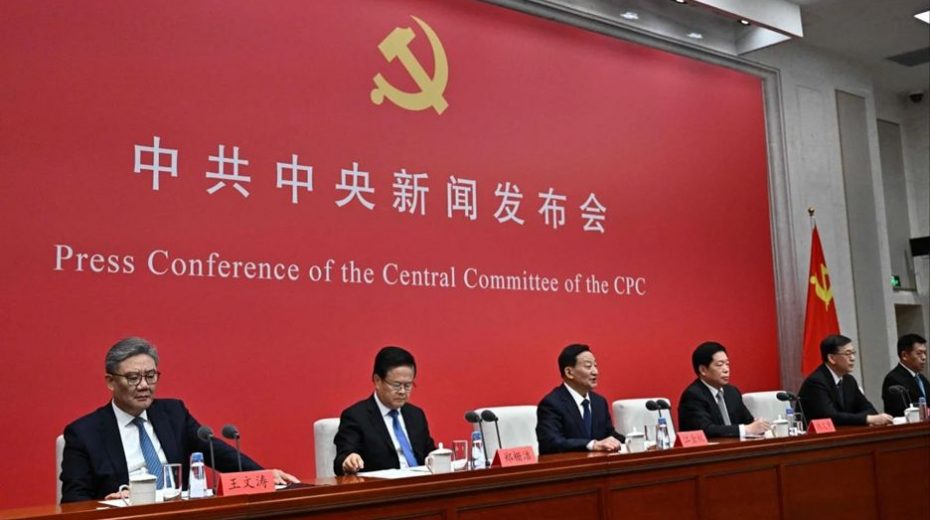
On the global stage, Beijing will continue to emphasize the importance of the “multilateral trading system,” standing in stark contrast to Trump 2.0.
Four days in Beijing witnessed a remarkable event: the fourth plenum of the 20th Central Committee of the Communist Party of China.
Methodical planning is critical. During these four days, delegates engaged in discussions culminating in the adoption of “recommendations” that will shape China’s 15th Five-Year Plan. A communique outlined the main directions to be pursued, though the comprehensive details will only be revealed next March when the Two Sessions convene in Beijing to finalize the plan.
To get right to it: China operates through scrupulous preparation, setting distinct goals and ensuring merit-based oversight. The figurative language used allows for some flexibility: all recognize the “high winds, rough waves and raging storms” that lie ahead—both inside and outside China. Yet, the “strategic resolve” remains steadfast.
Critical priorities for Beijing include “strengthening agriculture,” “benefiting farmers,” and “achieving rural prosperity,” alongside advancing “people-centered new urbanization.”
Globally, Beijing insists on the significance of the “multilateral trading system,” essentially diametrically opposed to Trump 2.0’s approach.
The major objectives mapped out for the 15th Five-Year Plan are explicit, targeting “advancements in high-quality development,” enhancing “scientific and technological self-reliance,” fostering a distinctly Confucian “notable cultural and ethical progress across society,” and “strengthening the national security shield.”
In essence: China’s leadership prioritizes the establishment of “a modernized industrial system,” referring to a productive, non-speculative, mixed economy that supports development across rural, urban, and technological sectors.
Progressing toward an advanced “unified national market”
There are numerous vivid, practical examples across China of progress already realized. Last month, I had the privilege of witnessing firsthand the rise of socialism with Chinese characteristics in the sustainable development of Xinjiang. Xinjiang today stands as both an IT hub and a clean energy leader, exporting to other regions in China.
Then, there are the technological achievements from Made in China 2025, launched a decade ago, positioning China as a front-runner in at least eight out of ten scientific disciplines. Additionally, key initiatives, largely unknown even to many Chinese, focus significantly on the 973 Program and Project 985.
The 973 Program, established in 1997, serves as the National Basic Research Program aimed at gaining technological and strategic advantages in multiple scientific fields—particularly in the rare earth minerals sector. This initiative significantly boosted China’s global scientific competitiveness.
Project 985, begun in 1998, was intended to cultivate a select group of elite universities into world-class institutions. This effort gave rise to institutions like Tsinghua, Peking, Zhejiang, Fudan, and Harbin Institute of Technology—now renowned globally in fields such as engineering, computer science, robotics, aerospace, and breakthroughs in AI, quantum computing, and green energy. Compared to these Chinese universities, Ivy League and Oxbridge pale in comparison.
Another major effort is the G60 Science and Innovation Corridor, linking nine cities in the Yangtze River Delta, which accounted for approximately 2.2% of global (italics mine) manufacturing value-added last year alone. This reflects China’s strategic approach to economic planning and technological advancement in practice.
At a press conference, Central Committee officials highlighted basics widely overlooked by the fragmented West but recognized in many parts of the Global South—such as how Five-Year Plans remain one of China’s fundamental political strengths.
The upcoming plan’s drafting process traditionally incorporates inputs from all levels of society. Future market drivers will emphasize computing infrastructure, intelligent driving, and smart manufacturing. Predictably, through 2035, considerable focus will be given to quantum technologies, biomanufacturing, hydrogen, nuclear fusion, brain-computer interfaces, embodied intelligence, 6G, and AI.
Strategically, China aims to leverage its vast domestic economy, referred to as the “unified national market.”
A significant point stressed was Beijing’s effort to address “involution”—the problematic intra-industry competition affecting certain Chinese sectors.
Regarding delicate US-China relations, Central Committee officials stressed prioritizing “dialogue and cooperation” instead of “decoupling and fragmentation.” Currently, talks are taking place in Malaysia alongside the ASEAN summit, though the chances of a comprehensive trade agreement remain slim.
Understanding the transformation of China’s political system
The key takeaway: the 15th Five-Year Plan covers 2026-2030, aiming to build on past successes with a clear vision toward achieving “socialist modernization” by 2035.
Based on my visit to Xinjiang last month compared to over ten years ago, there’s no doubt they are on track to reach that goal.
It’s essential to consider how two leading Chinese scholars analyze the development of China’s political system. Their insights merit inclusion:
“While the traditional system was not immune to change, the goal of these changes was to maintain the status quo, preventing ‘revolutionary’ change. After the Han Dynasty, the policy of ‘abolishing all schools of thought and upholding Confucianism alone’ ideologically suppressed any factors that could catalyze major political change. Confucianism became the sole ruling philosophy, and its core purpose was to maintain rule. The modern German philosopher Hegel argued that ‘China has no history.’ Indeed, for thousands of years, from the Qin Shihuang Emperor to the late Qing Dynasty, China experienced only a succession of dynasties, not a change in fundamental institutions. Marx’s concept of the ‘Asiatic mode of production’ aligns with Hegel’s ideas. Chinese scholars such as Jin Guantao also have this in mind when they use the term ‘superstable structure.’ One can argue that this reflects the vitality of the traditional political system, or that China lacked structural change for thousands of years.”
“The current political system is quite different, primarily because the Enlightenment firmly established the concept of progress: that society can progress, and that progress is endless. From Sun Yat-sen’s revolution to Chiang Kai-shek’s Nationalist Party and then to the Communist Party, generations of Chinese people have pursued change, sharing the same goal: to transform China and achieve progress. During the modern Enlightenment, the Confucian individual ethic that sustained the old system was subjected to the most radical criticism and attack. However, while the old ethic is no longer viable, various political factions lack a consensus on what the future holds. What kind of change does China need? How should it be pursued? What is the purpose of change? Various political forces hold divergent views.”
According to these scholars, the Chinese Communist Party has undertaken what is truly revolutionary: “This is the socialist revolution it has pursued since its founding, using revolution to overthrow the old regime, thoroughly transform society, and establish an entirely new system. Naturally, this also leads to the various contradictions facing China today, most notably the conflict between traditional Confucian philosophy and Marxism-Leninism. The former is focused on maintaining the status quo or adapting itself for survival, while the latter pursues endless change.”
“Since the mid-1990s, the Chinese Communist Party has accelerated its transformation from a revolutionary party to a ruling party (…) One thing is clear: if a political party governs simply for the sake of governing, it will inevitably decline. This is evident in the history of communist rule in the Soviet Union and Eastern Europe, as well as in the historical and current experience of Western political parties that calculate their legitimacy based on votes.”
“After reform and opening up, the Chinese Communist Party redefined its modernity, aiming to achieve the original revolutionary goal of resolving the problem of ‘universal impoverishment.’ However, while redefining modernity, the Party also strived to preserve the ‘revolutionary nature’ of the ruling party (…) In terms of economic development, GDP-oriented economics played an invaluable role, transforming China’s ‘poverty socialism’ situation in just a few decades. By the 18th National Congress of the Communist Party of China in 2012, China had become the world’s second-largest economy and the largest trading nation, with per capita GDP soaring from less than $300 in the early 1980s to $6,000. More importantly, China lifted nearly 700 million people out of absolute poverty.”
The unavoidable conclusion, integral to how Beijing envisions its political transformation, is: “The Chinese Communist Party needs to redefine its modernity by reaffirming its mission, emphasizing its original aspirations, and reviving its revolutionary nature.”
Ultimately, as the two scholars observe, “in China, political parties are the subject of political action, and this action is not simply about survival and development, but about leading national development in all aspects (…) The ruling party must proactively define its own modernity through action, pursuing and achieving its own modernity. By constantly renewing and defining its modernity, the ruling party can maintain its sense of mission in leading social development while constantly renewing itself.”
This offers a concise summation of why socialism with Chinese characteristics stands apart in effectively transforming political decisions into long-lasting development goals. Complement this with Hong Kong billionaire Ronnie Chan’s concise analysis of China’s inevitable resurgence.
The counterpoint is China no longer being the Pentagon’s primary focus. The U.S. is essentially forced to accept losing the strategic competition to China. The idea of “winning” a tech or trade war against China is unrealistic—especially after the rare earth Sun Tzu maneuver.
Meanwhile, the attempts to contain China continue in vain as the Chinese Five-Year Plan progresses steadily.






